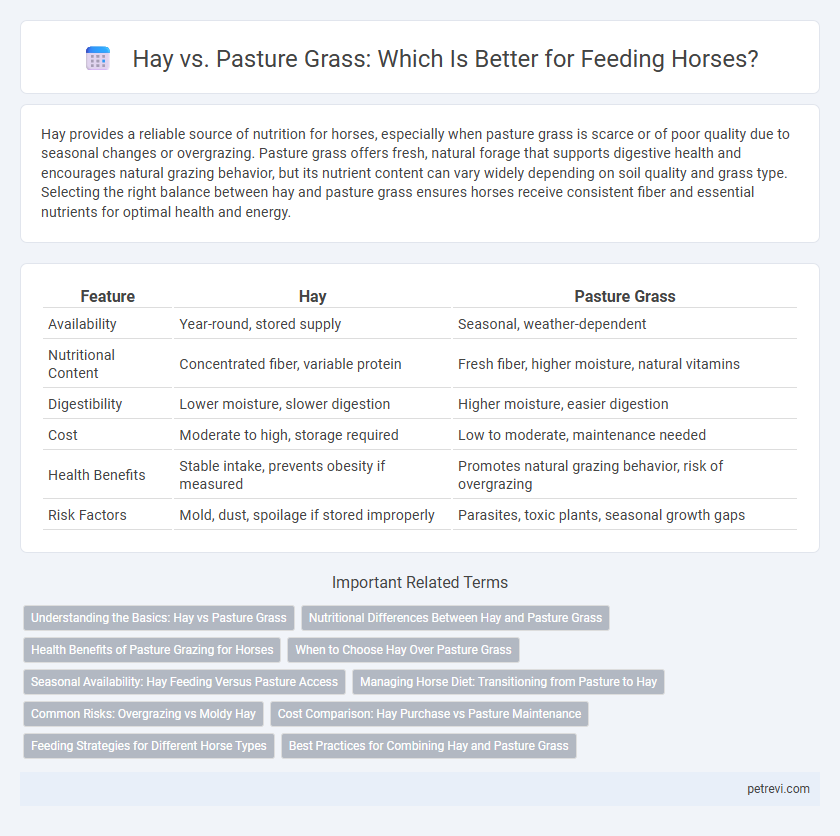Hay provides a reliable source of nutrition for horses, especially when pasture grass is scarce or of poor quality due to seasonal changes or overgrazing. Pasture grass offers fresh, natural forage that supports digestive health and encourages natural grazing behavior, but its nutrient content can vary widely depending on soil quality and grass type. Selecting the right balance between hay and pasture grass ensures horses receive consistent fiber and essential nutrients for optimal health and energy.
Table of Comparison
| Feature | Hay | Pasture Grass |
|---|---|---|
| Availability | Year-round, stored supply | Seasonal, weather-dependent |
| Nutritional Content | Concentrated fiber, variable protein | Fresh fiber, higher moisture, natural vitamins |
| Digestibility | Lower moisture, slower digestion | Higher moisture, easier digestion |
| Cost | Moderate to high, storage required | Low to moderate, maintenance needed |
| Health Benefits | Stable intake, prevents obesity if measured | Promotes natural grazing behavior, risk of overgrazing |
| Risk Factors | Mold, dust, spoilage if stored improperly | Parasites, toxic plants, seasonal growth gaps |
Understanding the Basics: Hay vs Pasture Grass
Hay and pasture grass serve distinct nutritional roles in horse feeding, with hay providing a reliable, dry forage source rich in fiber and essential nutrients, especially during seasons when fresh grass is unavailable. Pasture grass offers fresh, natural grazing that can enhance hydration and supply vitamins and minerals but varies in nutrient content depending on growth stage and soil quality. Selecting between hay and pasture grass requires consideration of factors such as horse health, forage availability, and dietary balance to optimize equine digestive function and energy intake.
Nutritional Differences Between Hay and Pasture Grass
Hay typically contains higher fiber content and more concentrated nutrients due to the drying process, making it an essential source of energy and roughage for horses, especially during winter or drought. Pasture grass provides fresh, moisture-rich forage with variable nutritional value that depends on the plant species, growth stage, and soil quality, often offering more vitamins and natural grazing benefits. Balancing hay and pasture intake helps maintain optimal digestive health, energy levels, and nutrient absorption in horses.
Health Benefits of Pasture Grazing for Horses
Pasture grazing provides horses with fresh, nutrient-rich grass that supports digestive health and mimics their natural feeding behavior, reducing the risk of colic and ulcers. The fiber content in pasture grass promotes stable hindgut fermentation, enhancing nutrient absorption and overall gut function. Rich in vitamins and minerals such as vitamin E and beta-carotene, pasture grass contributes to improved immune function and coat quality compared to stored hay.
When to Choose Hay Over Pasture Grass
Choose hay over pasture grass during winter months or drought conditions when fresh grass is scarce, ensuring a consistent fiber source for horses. Hay is optimal for horses with specific dietary needs, such as those prone to laminitis, as it has lower sugar content than lush pasture grass. Additionally, hay allows for controlled nutrient intake, reducing the risk of colic and other digestive issues when pasture quality is unpredictable.
Seasonal Availability: Hay Feeding Versus Pasture Access
Hay provides a consistent source of nutrition for horses during winter months when pasture grass is dormant or covered by snow, ensuring a steady intake of essential fibers and nutrients. Pasture grass, available in spring and summer, offers fresh, high-moisture forage rich in vitamins and minerals, promoting natural grazing behavior and hydration. Seasonal fluctuations in grass growth make hay a vital supplement to maintain equine health when fresh pasture is inaccessible.
Managing Horse Diet: Transitioning from Pasture to Hay
Transitioning a horse's diet from pasture grass to hay requires careful management to maintain nutrient balance and digestive health. Horses accustomed to fresh pasture should gradually increase hay intake over 7 to 10 days to prevent colic and digestive upset. Selecting high-quality hay with appropriate fiber and nutrient content supports energy needs and keeps horses healthy during seasonal pasture shortages.
Common Risks: Overgrazing vs Moldy Hay
Overgrazing pasture grass can lead to soil erosion, nutrient depletion, and reduced forage availability, posing significant risks to horse health and land sustainability. Moldy hay contains mycotoxins that can cause respiratory issues, colic, and weakened immune response in horses, making it a hazardous feed option. Proper pasture management and regular inspection of hay quality are essential to prevent these common risks and maintain optimal equine nutrition.
Cost Comparison: Hay Purchase vs Pasture Maintenance
Hay purchase for horse feeding involves upfront costs including harvesting, processing, and transportation, often making it a pricier option per bale. Pasture maintenance requires investments in soil fertility, seeding, weed control, and regular mowing, but offers long-term savings by providing fresh forage directly on-site. Evaluating overall expenses reveals pasture management can lower feeding costs over time compared to recurrent hay purchases, especially in favorable climates supporting year-round growth.
Feeding Strategies for Different Horse Types
Hay provides a consistent source of fiber and nutrients essential for horses unable to graze year-round, making it ideal for older, overweight, or stall-kept horses. Pasture grass, rich in natural sugars and moisture, supports active horses needing higher hydration and energy levels but requires management to prevent overgrazing and intake of harmful plants. Tailoring feeding strategies to horse type ensures optimal digestive health, energy balance, and weight maintenance by combining hay and pasture access according to activity level, age, and metabolic needs.
Best Practices for Combining Hay and Pasture Grass
Combining hay and pasture grass for horse feeding ensures a balanced diet rich in fiber, nutrients, and energy, supporting optimal digestion and health. Best practices include providing free-choice pasture access to encourage natural grazing while supplementing with high-quality hay during low pasture availability or poor grass growth periods. Monitoring forage quality, horse condition, and intake adjustments based on workload and season prevent nutritional imbalances and promote overall equine well-being.
Hay vs Pasture Grass for Horse Feeding Infographic

 petrevi.com
petrevi.com